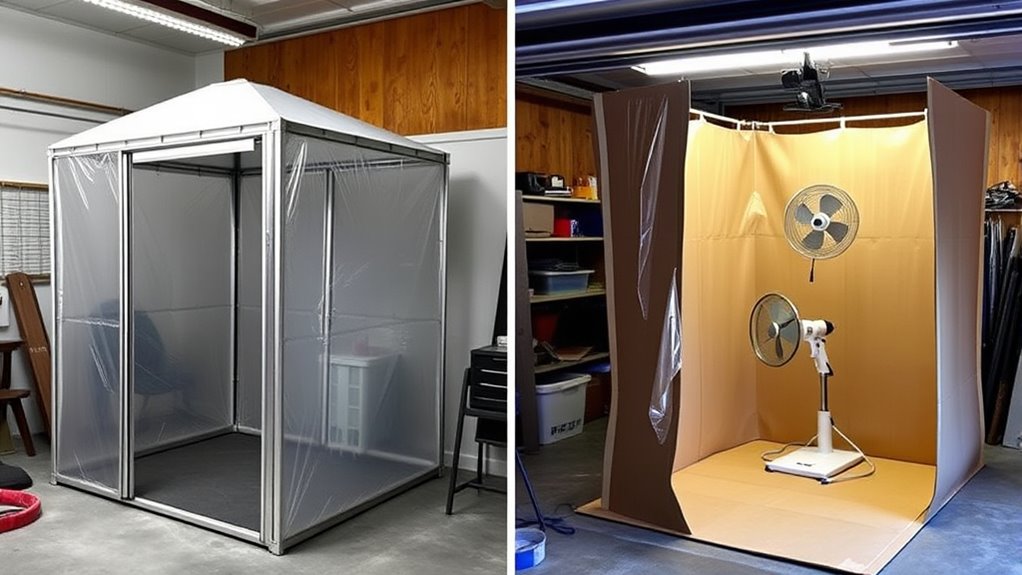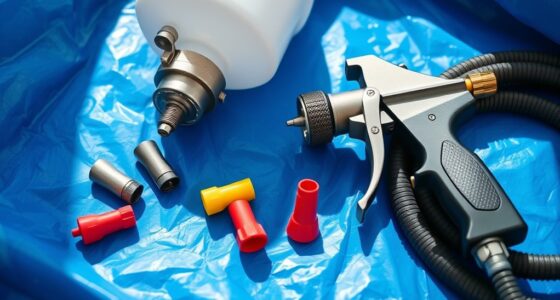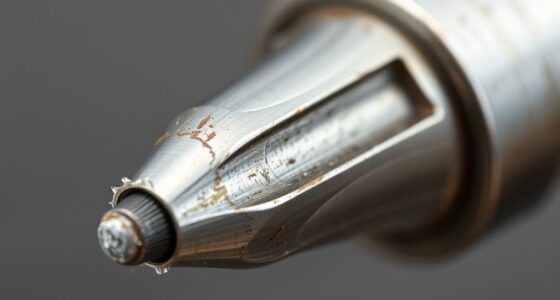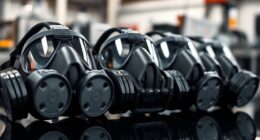Spray shelters are affordable and portable, making them ideal for occasional projects, but they lack advanced airflow, so fumes and overspray can linger, affecting safety and finish quality. DIY spray booths, though more costly and time-consuming to set up, provide better ventilation, safer environment, and a more professional finish for frequent or large-scale work. To choose the best option for your needs, understanding the differences in ventilation and costs will help you make an informed decision.
Key Takeaways
- Spray shelters are affordable and quick to set up but offer limited ventilation, impacting safety and finish quality.
- DIY spray booths require higher initial investment but provide better airflow, reducing fumes and overspray.
- Proper ventilation in DIY booths enhances safety and results in a cleaner, more professional finish.
- Spray shelters are ideal for occasional projects, while DIY booths suit frequent or large-scale spray painting.
- Long-term, DIY booths can be more cost-effective due to improved efficiency and environment control.
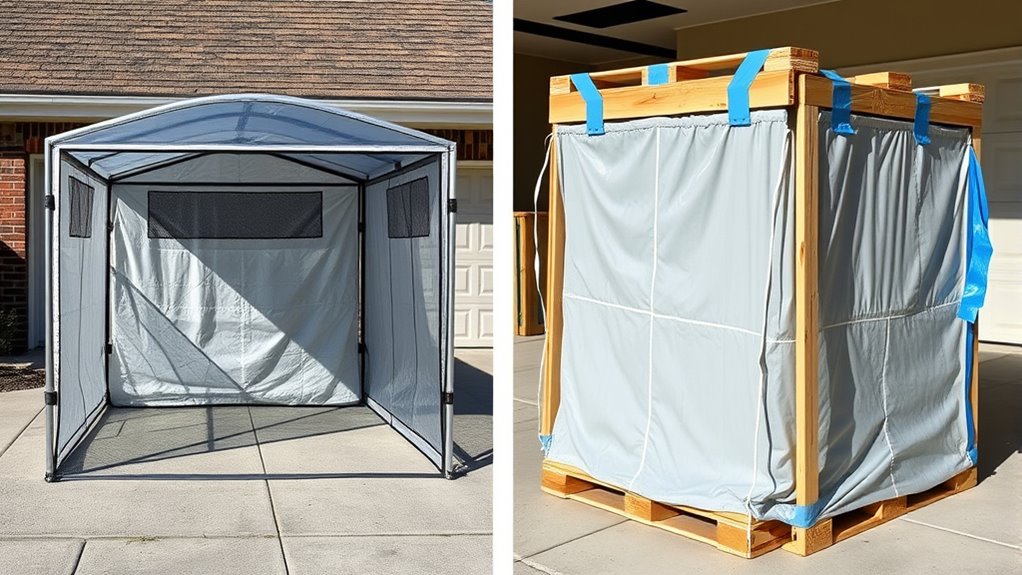
When choosing the right setup for spray painting, you might wonder whether a spray shelter or a DIY spray booth is the better option. One of the first considerations is ventilation efficiency. A spray shelter, typically made of lightweight fabric or plastic, offers basic ventilation but often lacks the advanced airflow systems of a dedicated spray booth. This means fumes and overspray can linger longer, reducing ventilation efficiency and potentially compromising both safety and finish quality. On the other hand, a DIY spray booth, especially one assembled with proper fans and filters, can provide better airflow management. Properly designed, a spray booth directs fumes away from your workspace, improving ventilation efficiency considerably. This is essential because it not only protects your health but also results in a cleaner, more professional finish by reducing airborne dust and overspray settling on your work. Ensuring proper ventilation systems is key to optimizing your spray environment.
Cost comparison plays an important role in your decision-making process. Spray shelters are generally more affordable upfront, often costing less than a DIY spray booth. They are simple to set up and require minimal investment, making them appealing if you’re on a tight budget or only occasionally spray paint. However, their lower cost comes with limitations. Because they lack sophisticated ventilation systems, you might need to invest in additional equipment like portable fans or exhaust systems to improve airflow, which can add to the overall expense. Conversely, a DIY spray booth can be more cost-effective in the long run if you plan to do frequent or large-scale spray projects. While the initial setup—buying fans, filters, and constructing the booth—may be pricier, it offers better control over the spray environment. The improved ventilation efficiency means you spend less on cleanup and fewer materials wasted due to overspray or imperfections caused by poor airflow.
Ultimately, your choice hinges on how often you’ll be spray painting, your budget, and your safety priorities. If you only need a temporary, low-cost solution for small projects, a spray shelter might suffice, but keep in mind that its ventilation efficiency may be limited. If you’re serious about achieving high-quality finishes regularly, investing in or building a DIY spray booth with proper ventilation can pay off in the long run. It provides a safer, cleaner, and more efficient environment for spray painting, making it worth the extra effort and expense. Both options have their merits, but understanding the differences in ventilation efficiency and cost comparison helps you make an informed decision tailored to your needs.
Frequently Asked Questions
What Are the Cost Differences Between Spray Shelters and DIY Spray Booths?
You’ll find spray shelters are generally more budget-friendly compared to DIY spray booths, making them ideal if you’re watching costs. DIY booths tend to require higher investment due to durable materials and custom setups. Consider your budget and material durability needs—if you need long-lasting, sturdy options, a DIY booth might be worth the extra expense. For temporary or light use, a spray shelter usually offers an affordable, convenient solution.
Which Option Offers Better Airflow and Ventilation?
You’ll find that DIY spray booths typically offer better airflow efficiency and ventilation quality than spray shelters. Studies show that proper ventilation reduces airborne contaminants by up to 90%. With a DIY booth, you can customize fan placement and exhaust systems, ensuring consistent airflow. Spray shelters often lack this level of airflow control, making DIY options the superior choice if ventilation is your priority.
How Easy Is It to Set up Each Solution?
You’ll find spray shelters very easy to set up due to their portable convenience; most require just unfolding or minimal assembly. DIY spray booths, on the other hand, tend to have higher setup complexity, often involving building and installing ventilation systems, frames, and barriers. If quick and straightforward installation is your priority, spray shelters are the better choice, while DIY booths demand more time and effort upfront.
Are Spray Shelters Portable for Mobile Work?
A spray shelter is as portable as a backpack full of your favorite tools, making it perfect for mobile work. Its lightweight, foldable design offers unmatched mobility ease, allowing you to set up and pack down quickly wherever your project takes you. You’ll love how effortlessly you can transport it, giving you the flexibility to work on-site or from your truck bed without breaking a sweat.
What Maintenance Is Required for Each Type?
You need to regularly check and clean the ventilation systems in both spray shelters and DIY spray booths to guarantee proper airflow and safety. Follow cleaning routines that include removing dust, paint overspray, and debris from filters and filters covers. For spray shelters, keep the fabric or material clean and inspect for tears. In DIY booths, regularly service fans and replace filters to maintain peak operation and prevent buildup that could affect paint quality.
Conclusion
Ultimately, choosing between spray shelters and DIY spray booths depends on your needs and budget. While spray shelters are ready-made and hassle-free, DIY booths let you customize to fit your space and projects. Don’t put all your eggs in one basket—consider what’s most practical for you. Remember, sometimes you have to roll with the punches and adapt to what works best. Whichever route you take, safety and quality should always be your top priorities.
